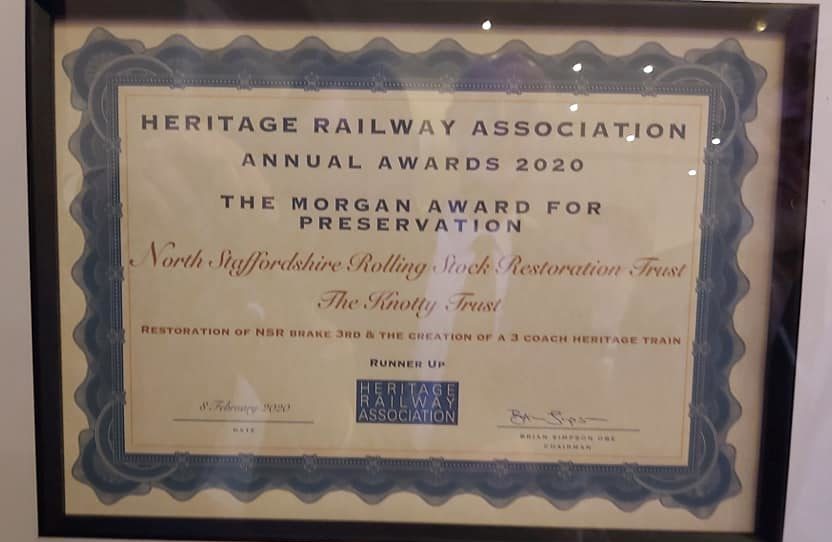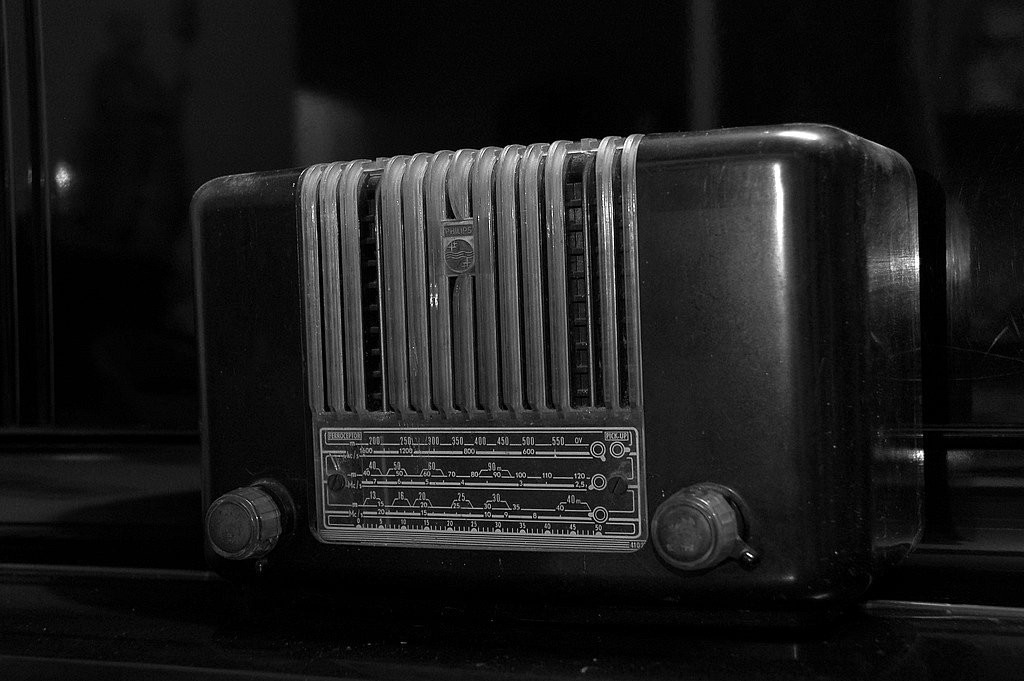
On Friday 26th of June 2020, around 12:10 a member of the Trust will be talking to Steve Jenner on ‘Moorlands Radio’ about the Appeal for ‘Old Mr Heath’ . You can listen live here : http://www.moorlandsradio.co.uk/player/

On Friday 26th of June 2020, around 12:10 a member of the Trust will be talking to Steve Jenner on ‘Moorlands Radio’ about the Appeal for ‘Old Mr Heath’ . You can listen live here : http://www.moorlandsradio.co.uk/player/

In March of 2020 the Knotty Coach Trust became the owners of Robert Heath No. 6, built in Biddulph, North Staffordshire in 1886. When restored the Trust plan to use the locomotive to haul the three coach NSR Heritage Train (to be augmented by a fourth coach, NSR 1st 228 in time) based on the Foxfield Railway.
The locomotive was stripped for restoration some years ago but cost of overhauling the boiler became prohibitive. Prior to the Foxfield Railways Covid – 19 shut down the smoke box was returned to the frames as the first conservation move by the new owners.
Appeal
The Trust have set a initial appeal target of £20,000 in order that restoration may begin, a generous loan by a Trustee and ring fenced funding means that the Trust are within £7000 of the target. To this end the Trust are asking for donations, cheques should be made out to the NSRRSRT and sent to Jon Beardmore, 9 Ouse Close, Wellingborough, NN8 5ZF
Initial tasks include the manufacture of a new smoke box tube plate and a new set of springs, the locomotive will be cosmetically restored by the Autumn of 2021.
The KCT have an excellent track record of fund raising and project completion, the return to steam will be costly as the full boiler overhaul will almost certainly require the removal of the firebox, the manufacture of new girder stays and of course a re tube.
Connection with NSR coaches
There is a connection between Robert Heath & Sons and the NSR/ Knotty coaches. Apart from the trips No. 6 would have made between Norton and Black Bull along the Biddulph Valley line for maintenance, in his book ‘Industrial Locomotives of North Staffordshire’ , Allan Baker details how in 1912 an explosion at Norton colliery led to Heath’s hiring a train of Knotty four wheel coaches, and ran trains using their own unfitted locomotives for around six months, carrying Ford Green workers to Black Bull to keep some of them employed at a time of great local hardship. As the last surviving Heath loco No. 6 further helps connect the industrial Foxfield Railway with the NSR and the Knotty Heritage Train.
Local ironmaster Robert Heath was a descendant of Caverswall farmer William Heath and his wife Mary who farmed in the village from the 1770’s. By 1885 Robert Heath’s company was expanding rapidly at its Black Bull and Ford Green (Norton) sites, around three miles apart and connected by the North Staffordshire Railway’s Biddulph Valley Line. In need of more locomotives the company used the recently arrived Falcon Engine Company loco (Heath’s No. 8) as a template to build No. 6 at the Black Bull workshops, the first of a dozen such locos. The loco then spent the next three quarters of a century working at Norton and Black Bull through the rise and fall of the Heath empire. In 1919 Robert Heath & Sons amalgamated with the Low Moor Company of Bradford. In 1928 iron and steel making came to an end and the Norton & Victoria collieries were taken over by Robert Cadman’s Norton & Biddulph Collieries Ltd, with the Black Bull workshops becoming part of his Cowlishaw Walker engineering company.
In 1934 No. 6 was rebuilt at Black Bull and in 1947 became part of the National Coal Board fleet following nationalisation. By 1954 the National Coal Board was introducing diesels to its fleets in the area, but No. 6 was fortunate to be selected to receive a new boiler from WG Bagnall Ltd, to serve as a standby to the new locos. In 1969, with its industrial working life at an end, the loco was preserved and it moved to Shugborough Hall.
When the Shugborough collection was disbanded in 1984 No. 6 went to Chatterley Whitfield, from where it was sent to Dorothea Restorations for a return to steam wearing Norton & Biddulph Collieries Ltd lined green livery ready for its role at the Garden Festival at the former Shelton Bar site at Etruria. Foxfield volunteers helped crew No. 6, as it shuffled up and down the demonstration line with a short rake of wagons and so formed an early bond with footplate crews, which would be developed when the loco later moved to Caverswall Road in 1994.
In early 1994 Robert Heath No.6 faced an uncertain future. The loco had, since its initial restoration in time for its centenary and operation at the 1986 National Garden Festival at Etruria, been in steam regularly at Chatterley Whitfield Mining Museum. The closure of the Museum in 1993 led to the assets, including the loco, being listed for sale at auction and there were suggestions that potential bidders might be looking to take No. 6 away from North Staffordshire. The Foxfield Railway seemed a natural home for a machine with such deep roots in the area’s industrial past, and various options to secure the loco for the railway were explored.
Once at Foxfield minor repairs were carried out to enable No. 6 to make its first steamings and it appeared as one of nine locos in action at the 1994 steam gala but being without vacuum brake it was restricted to pilot duties at Blythe Bridge exchange sidings. At the end of the 1998 season No. 6 was withdrawn for a boiler overhaul, carried out on site at Foxfield returning to traffic for the 1998 steam gala, now wearing a (temporary) weathered black livery.
In the autumn the loco made its first working outside North Staffordshire when it was involved in a photo charter at the now-closed Snibston Discovery Park, appearing alongside the unrestored Brush 0-4-0st No. 314 which was built in 1906 at the former Falcon Loughborough works where Robert Heath No. 8 had been built. The overhaul included fitting the loco with vacuum brake and it worked its first solo passenger trains, proving a competent performer on two Mk1’s. A repaint into lined black livery was completed in time for the Foxfield gala in 2000. In 2001 it made a working visit to Workington Steelworks and over the following years visited various heritage railways including the Midland Railway at Butterley, Ribble Steam Railway, the National Railway Museum’s Shildon outpost and Lincolnshire Wolds. Whilst at Butterley it worked the railway’s vintage train of five beautifully restored passenger vehicles and offered a taste of what could be when the KCT based at Foxfield assembled a vintage train of its own.
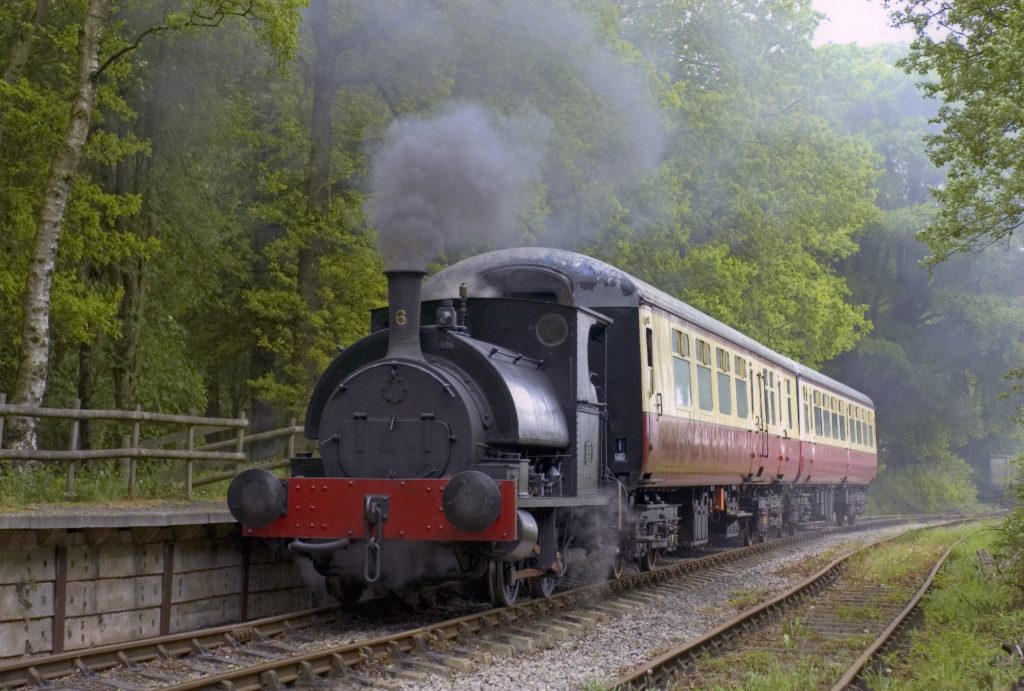
In May 2008 No.6 came out of traffic for overhaul and in the last 12 years intermittent progress was made on its restoration. As with many overhauls the boiler becomes the biggest challenge and with No. 6 it is no exception.
© 2020 The NSR Rolling Stock Restoration Trust. Registered Charity No. 1127895
Due to the Coronavirus outbreak we have had to postpone our running of the Knotty Heritage train until further notice. As soon as the situtation becomes clearer we will let you know via this website and social media.
A thriving steam railway and a prison in the West Midlands have joined forces to restore a unique museum exhibit: a railway wagon used to carry ammunition and war supplies over 100 years ago.

The World War I Ammunition Wagon project is a new initiative by the Knotty Coach Trust, a charity based at Foxfield Steam Railway near Stoke-on-Trent, and HMP Dovegate, in nearby Uttoxeter. During 2020, the 6 tonne wagon will be restored at the Prison workshops, to help develop prisoners’ skills in large scale woodwork, metalwork, painting, heritage restoration and project management. The project will cost almost £20,000 and has attracted grant support from The National Lottery Heritage Fund, the Garfield Weston Foundation, the Trusthouse Charitable Foundation and donations from supporters in memory of a British soldier who died in 1918. Support from The National Lottery Heritage Fund has come through its ‘First World War: Then and Now’ programme, and the project highlights the role of women in the conflict, who worked long hours under very hazardous conditions to produce rifle bullets and shells for the large guns overseas. The wagon was used to transport ammunition and all sorts of essential supplies and materials from the factories on the British mainland to the trenches of the Western Front in France and Belgium.
HMP Dovegate is a Category B prison managed by SERCO, that houses over 1,000 long term prisoners as well as having a local remand function. One of the prison’s fundamental roles is to equip prisoners for release by instilling a work ethic, providing skills and opportunities that would assist them on release and ultimately reduce re-offending. Around 20 prisoners will work six hours per day in Purposeful Activity for a five day week on the project, enabling them to learn and develop skills that will be valuable on their release, not only for heritage restoration, but also for building, decorating and landscape gardening. Training will be led by SERCO’s tutor Kim Brassington, who has visited the carriage and wagon workshop at the Midland Railway Centre at Butterley, near Ripley, to see a similar project. Some of the external grant funding is being used to equip the prison workshop, and fund experienced heritage restoration experts to visit the prison and share their knowledge of traditional techniques. Prisoners will also learn about the history of the wagon and help to build some of the educational displays, led by the Knotty Coach Trust’s Chairman and manager of the project, Mark Smith.
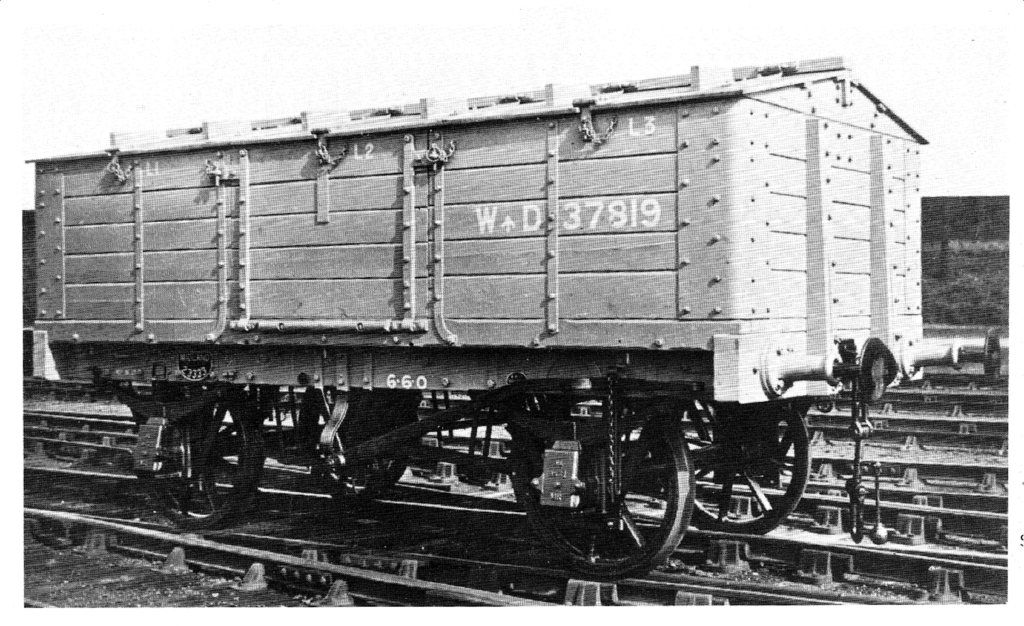
The railway wagon itself is over 100 years old; built in Derby Works by the Midland Railway and converted by the British War Department in 1917 for its role in the global conflict that lasted from 1914-18. Later it was used at an Army depot numbered 46370, and ended up in a quarry in North Wales from where it was rescued from scrapping in 1987 by a member of the Foxfield Railway Society. Now in the ownership of the Knotty Coach Trust, which has restored the Victorian ‘Knotty Heritage Train’ as a popular local attraction, the wagon had deteriorated through storage in the open for the previous 30 years. The major iron and steel components will be restored at the prison and the superstructure rebuilt using new timber, to match the original drawings. Special air-dried oak will be used for the main frames, all worked by hand using traditional wagon-building techniques, and painted in the Admiralty Grey colour it carried in 1917-18. Once completed and moved back to Foxfield Steam Railway, the wagon will be displayed with examples of some of the goods it used to carry and an explanation about the “Munitionettes” – the women who made them – and the “Tommies” – the men who used them.
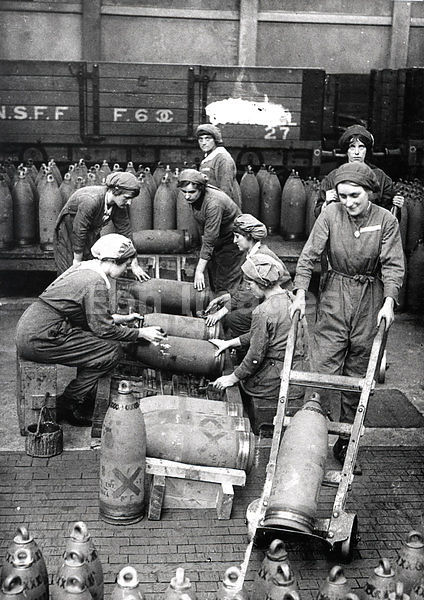
It will be fully operational and demonstrated behind steam locomotives on selected dates in 2021, and is the first wooden Victorian style wagon to be restored on the line for many years, the basic vehicle being typical of the freight rolling stock on a former colliery railway.
Chairman of the Foxfield Steam Railway Mr Ron Whalley said: “The Knotty Coach Trust has already achieved the thorough restoration of three Victorian carriages which bring delight to our passengers every year. The Foxfield Railway Society has a long-held ambition to restore its collection of traditional wooden wagons from a century ago, and this Ammunition Wagon represents the first step in achieving that ambition.”
John Hewitson, Serco Contract Director at HMP Dovegate, said, “Our prison workshops have already produced some very useful timber components for carriage restoration at Foxfield Railway and so we are very pleased to take this collaboration to the next level and rebuild a complete railway wagon in-house. The range of opportunities for skills training are tremendous. All the prisoners who work on the carriage can feel justifiably proud of their achievement when we roll it out finished later this year. They are learning skills that will help them gain employment and prevent reoffending on their release back into society, breaking the cycle of crime and reoffending.”
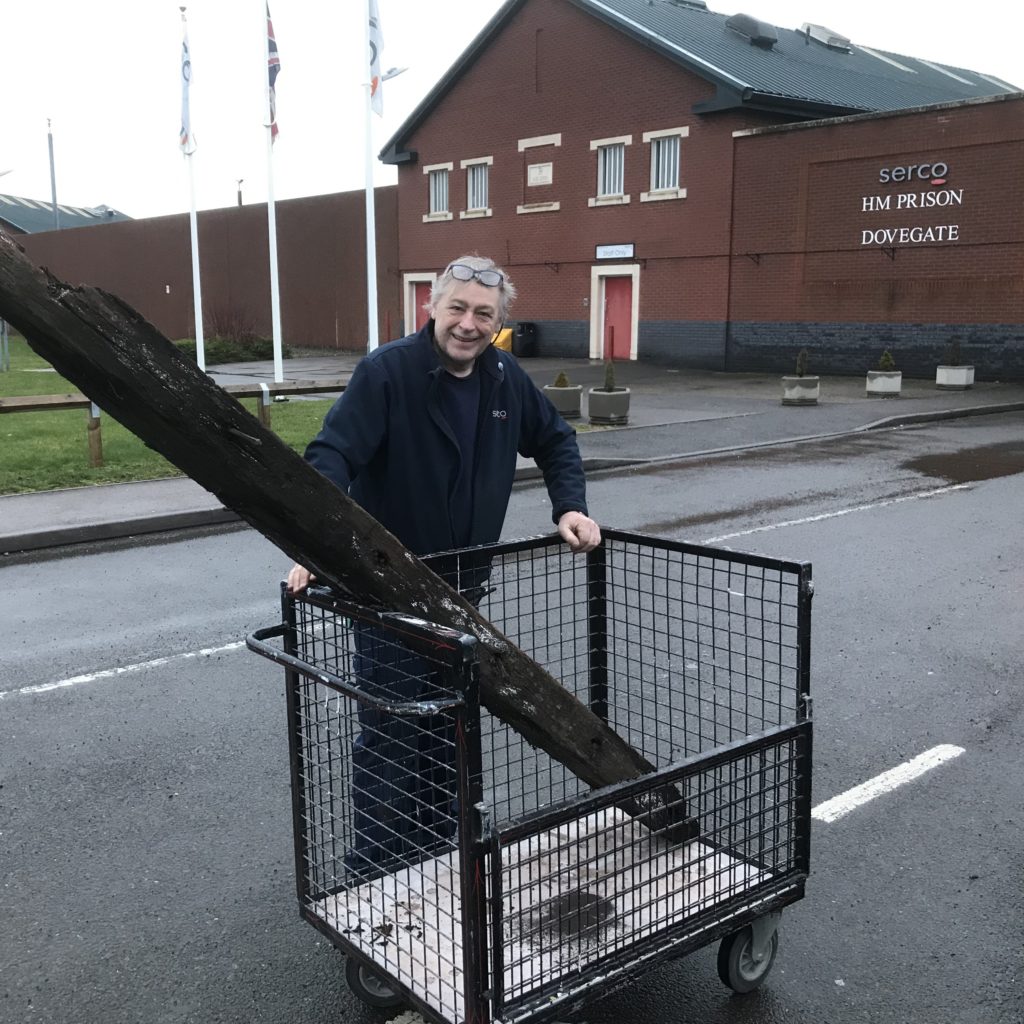
A grand-daughter of the late Private Job Wilson (who died of wounds from the second battle of Cambrai, on 8 October 1918) who contributed a significant anonymous donation towards the costs of the project, said “It is poignant to remember the sacrifice of so many young men, such as my grandfather Job Wilson, who gave their lives in the trenches. And to link them back to so many women who suffered long term health issues as a result of the work they did in the munitions factories to supply them with the equipment for war.”
Chairman of the Knotty Coach Trust Mark Smith said “The Trust would like to thank the team at Dovegate Prison for approaching the Foxfield Steam Railway to take on an ambitious project such as this. We would also like to thank the grant funders which have made it possible to purchase the materials and equip the prison workshop, especially thanks to the players of the National Lottery, whose grant has contributed half the costs.”
Anne Jenkins, Director, England, Midlands & East at The National Lottery Heritage Fund said: “We are excited to support the Knotty Coach Trust in the restoration of the WWI Ammunition Wagon, while also showcasing the pivotal role that women played in the global conflict, with money raised by National Lottery players. This project will ensure the Wagon can be admired for years to come, and also provide opportunities for people to explore their past and create stories for the future.”
We are pleased to annonce that the Knotty Trust has been awarded runner up for the Morgan Award for Preservation.
